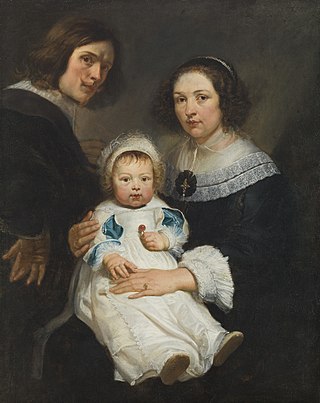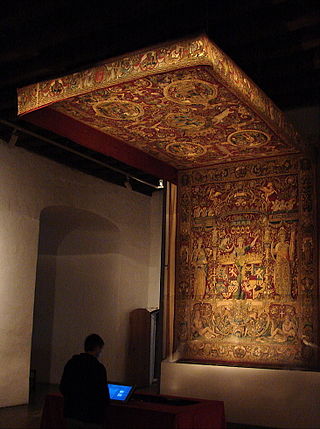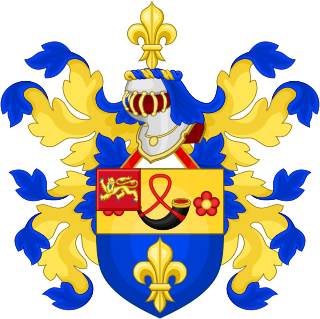
The Dermoyen family [lower-alpha 1] included a number of prominent weavers and dealers of Brussels tapestry in the 1500s. [1]

The Dermoyen family [lower-alpha 1] included a number of prominent weavers and dealers of Brussels tapestry in the 1500s. [1]
Jan [lower-alpha 2] and Willem [lower-alpha 3] [2] were weavers of large tapestries, in some cases for royal and imperial courts.
Jan and Willem are credited with leading the weaving of the Battle of Pavia tapestries in about 1528 to 1531. [3] [4] [5] In this, they worked with Bernard van Orley.
Jan and Willem also led the weaving of the Hunts of Maximilian tapestries in about 1531 to 1533. [6]
Jan is credited as having led the weaving of the Story of Cyrus tapestries that are now in the Isabella Stewart Gardner Museum. [7]

Tapestry is a form of textile art, traditionally woven by hand on a loom. Normally it is used to create images rather than patterns. Tapestry is relatively fragile, and difficult to make, so most historical pieces are intended to hang vertically on a wall, or sometimes horizontally over a piece of furniture such as a table or bed. Some periods made smaller pieces, often long and narrow and used as borders for other textiles. Most weavers use a natural warp thread, such as wool, linen, or cotton. The weft threads are usually wool or cotton but may include silk, gold, silver, or other alternatives.

The Isabella Stewart Gardner Museum is an art museum in Boston, Massachusetts, which houses significant examples of European, Asian, and American art. Its collection includes paintings, sculpture, tapestries, and decorative arts. It was founded by Isabella Stewart Gardner, whose will called for her art collection to be permanently exhibited "for the education and enjoyment of the public forever."

Bernard van Orley, also called Barend or Barent van Orley, Bernaert van Orley or Barend van Brussel, was a versatile Flemish artist and representative of Dutch and Flemish Renaissance painting, who was equally active as a designer of tapestries and, at the end of his life, stained glass. Although he never visited Italy, he belongs to the group of Italianizing Flemish painters called the Romanists, who were influenced by Italian Renaissance painting, in his case especially by Raphael.

Johannes Stradanus was a Flemish artist active mainly in 16th-century Florence, Italy. He was a wide-ranging talent who worked as an easel and fresco painter, designer of tapestries, draughtsman, designer of prints and pottery decorator. His subject range was varied and included history subjects, mythological scenes, allegories, landscapes, genre scenes, portraits, architectural scenes and animals. After training in his native Flanders, he left his home country and ultimately settled down in Florence, Italy. He became a prominent court artist to the Medici during the second half of the 16th century and worked on the many decorative projects of the court. Stradanus also produced large altarpieces for the most important churches in Florence.

Jan Snellinck or Jan Snellinck (I) (c. 1548 – 1 October 1638) was a Flemish painter, draughtsman and designer of tapestries, prints and frescoes. He is known for his large altarpieces and was also recognized as a leading battle painter in his time. Snellinck was active as an art dealer and art collector.

Peter de Witte, known in Italy as Pietro Candido and in Bavaria as Peter Candid was a Flemish-born Mannerist painter, tapestry designer and draughtsman active in Italy and Bavaria. He was an artist at the Medici court in Florence and at the Bavarian court of Duke William V and his successor Maximilian I in Munich.

Erasmus Quellinus the Younger or Erasmus Quellinus II was a Flemish painter, engraver, draughtsman and tapestry designer who worked in various genres including history, portrait, allegorical, battle and animal paintings. He was a pupil of Peter Paul Rubens and one of the closest collaborators of Rubens in the 1630s. Following Rubens' death in 1640 he became one of the most successful painters in Flanders. He was a prolific draughtsman who made designs for decorative programmes in the context of official celebrations, for publications by the local publishers and for tapestries and sculptures realised by the local workshops. His work reveals the Classicist trend in the Baroque.

Jan Miense Molenaer, was a Dutch Golden Age genre painter whose style was a precursor to Jan Steen's work during Dutch Golden Age painting. He shared a studio with his wife, Judith Leyster, also a genre painter, as well as a portraitist and painter of still-life. Both Molenaer and Leyster may have been pupils of Frans Hals.

Aert Schouman or Aart Schouman was an 18th-century painter, now better known as a glass engraver, from the Dutch Republic.

Brussels tapestry workshops produced tapestry from at least the 15th century, but the city's early production in the Late Gothic International style was eclipsed by the more prominent tapestry-weaving workshops based in Arras and Tournai. In 1477 Brussels, capital of the duchy of Brabant, was inherited by the house of Habsburg; and in the same year Arras, the prominent center of tapestry-weaving in the Low Countries, was sacked and its tapestry manufacture never recovered, and Tournai and Brussels seem to have increased in importance.

The family of de Pannemaeker or de Pannemaker were tapestry weavers from the Southern Netherlands, more or less equivalent to modern-day Belgium. Pieter de Pannemaeker, working from Brussels, was a celebrated weaver who, for European royalty, created tapestries resplendent with gold and silver threads, and expensive fine silks and woollen items. In 1520, Pieter de Pannemaeker commissioned the artist Bernard van Orley to make tapestry cartoons for his workshop. A surviving fragment depicts the Allegory of the Four Winds. Pannemaeker was court weaver to Margaret of Austria, Regent of the Southern Netherlands, who commissioned the Passion in four parts, and in 1523, she ordered an imposing dais made up of three tapestries, which later featured in the abdication ceremony of Emperor Charles V.

Jacob van Oost or Jacob van Oost the Elder (1603–1671) was a Flemish painter of history paintings and portraits. He was the most important painter of Bruges in the 17th century through his portraits of members of the local bourgeois and his many altarpieces made in the spirit of the Counter-Reformation. He also created genre paintings of musicians and card players for the open market.

Hans Knieper was a Flemish painter and draughtsman.He became a court painter and tapestry cartoon designer at the Royal Danish Court and ran a tapestry weaving shop in Denmark.

Willem de Pannemaker, was a leading weaver of Brussels tapestry. He was the head of the Pannemaker tapestry workshop, was considered the greatest tapestry creator for his time, and is best known for his works for the Habsburgs.

The Rubens family is a Flemish noble family that lived in Antwerp.

The Hunts of Maximilian or Les Chasses de Maximilien, also Les Belles chasses de Guise are a set of twelve tapestries, one per month, depicting hunting scenes in the Sonian Forest, south of Brussels, by the court of Maximilian I, Holy Roman Emperor. They were produced in a Brussels workshop, and several tapestries are given identifiable locations that were then around the outskirts of the city, but are now mostly engulfed by it. The set is now in the Louvre.

The Leyniers family (/lɛnɪjɛ/) is a bourgeois family that appeared in Brussels in the 15th century and produced many high-level tapestry makers and dyers, experts in the art of dyeing in subtle shades the woolen threads destined for this trade.

Jacob Herreyns or Jacob Herreyns (I) Antwerp, baptized on 23 December 1643 – Antwerp, 1 January 1732) was a Flemish painter, printmaker and designer of tapestries. He worked in Antwerp where he painted many altarpieces. He was a known staffage painter who added the figures in the landscapes of other artists. As a printmaker, he produced mostly prints of mythological subjects. He held also the position of 'muntmeester' (mint master) of Brabant.

The Battle of Pavia tapestries are a set of seven tapestries made from about 1528 to 1531 depicting events from the Battle of Pavia of 24 February 1525.